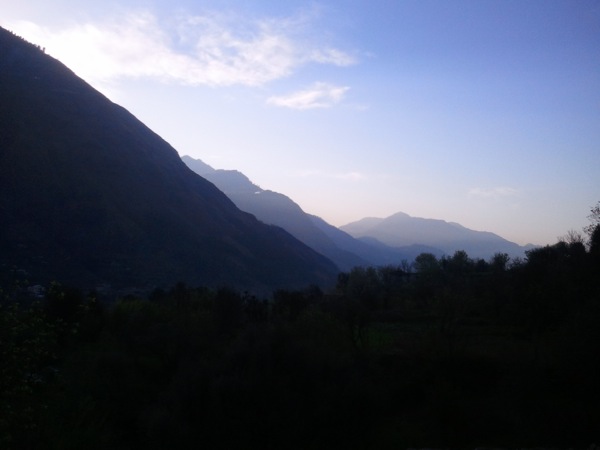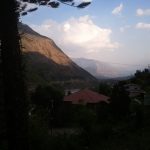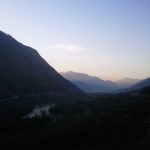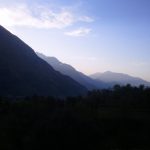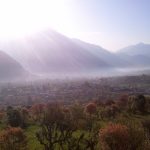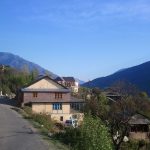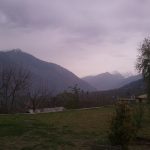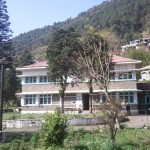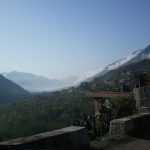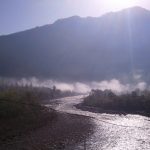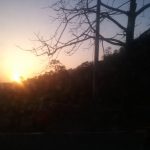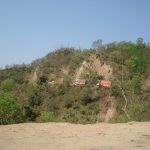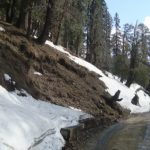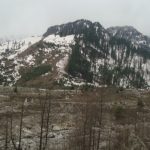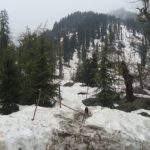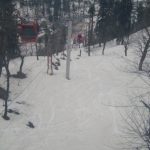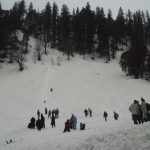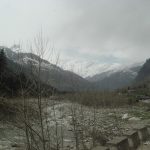The journey starts at Hazrat Nizamuddin station, New Delhi and I am taking the Rajdhani, which is the fastest super express train that is run by the Indian Railways. I have chosen to travel by the 2nd AC class, which, at 3100 rupees, is about a thousand rupees more expensive than the 3rd AC class, while being much cheaper than 1st AC, which costs around 5500 rupees.
If you ask me, the upgrade is seriously not worth it. You get pretty much the same food (I think served in better cutlery), marginally better service and about double the space. For that kind of money, I would rather fly, but we won't get into that digression.
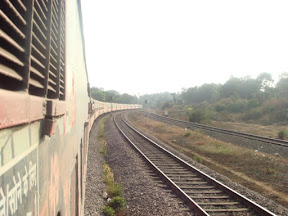 |
| Yes, we were at the tail end |
As far as stations go, Nizamuddin is one of the better ones in Delhi, especially when compared to the awful mess called New Delhi Railway Station. Though, on an absolute scale, it is still way too dirty for my liking. Purchases here include two chains and two locks (both open with the same key, so much for security), but this is my first journey on this line in about 5-years and old habits are hard to kill, especially when you have a laptop in one of your bags. You can't ever be too careful when you are travelling.
The train pulls out of the station, as scheduled, at 11 AM, from Nizammudin. Before we proceed, a word of warning about the Rajdhanis, They are crazy fast trains (at least by Indian standards) and stop only for a very short while at the dozen scheduled stops. The maximum time at any halt is ten minutes. If you are fond of wandering about at the stations, do keep that fact very much on top of your consideration. If you happen to get left behind, unless someone pulls the chain, the odds of being able to 'catch up' is rather remote.
Now, coming back to the actual journey, I found the coaches to be old and creaky. From both inside and the outside it looks like they were from an earlier batch and the speed limit is recommended at 130 KMPH. Amenities on-board include curtains, a reading light and a plug point (which is a two-pin standard Indian plug point, some have three pin plug points too). As soon as I enter, I discover a cockroach and a small rat makes the first of its many journey-long celebrity-style appearances.
Food (vegetarian and non-vegetarian ) delivered at at near-point blank range to your mouth is one of the better things about the Rajdhanis. The feeding frenzy starts with snacks and by the end of the day you'd have done lunch, another round of snacks for tea and dinner. If you are prone to constant calorie carping, this is your worst nightmare. With 42 hours of near-zero exercise and three full meals and two snacks in a day, I can bet that laden weight, at the time of arrival at the destination on these trains will almost always be higher than what they started out with.
For those who consider being constant connected as one of the fundamental rights the news is not that bad. The phone coverage is reasonable through the duration of the journey, other than in patches where it can disappear for about 20 minutes to 40 minutes. I was able to use GPRS with reasonable ease when the signal levels were good and with Opera Mini in tow, you should be able to do most of your online stuff.
 |
| The food and the bad |
The journey
The first two states you cross while getting out of Delhi are U.P and Haryana. In all honesty, the parts of those states you cover while fleeing Delhi on rails are not even worth a look. So we will jump straight into Rajasthan, where we will also make our first stop — at Kota — at 3:30 PM. By now, the first main meal — lunch has already happened and the first brush with the IRCTC's rendition of soup and food leaves you with an overpriced aftertaste on the palette and the mind.
For a state that is meant to be mostly desert, Rajasthan can often surprise you with how green it actually is. During a trip to Jaisalmer in in 2007, one of the locals told me that after the floods that year, most of the state turned green, leaving a bad impression on tourists who came seeking the sand and the desert. Kota, incidentally, is a lovely little station and we stop for ten minutes there, following which tea is served.
Next stop is at Vadodra in Gujarat, which is scheduled at at 10:30 PM.
I have two other guys, middle aged, in my section, who are off to do an energy audit at Mangalore. Apparently, they have forgotten the check list needed to do the audit and were busy trying to arrange for them. They did not appear too friendly, returning my hello and casual “where are you headed” query with the shortest of short replies. Maybe it was also the fact that my bomber jacket and Murakami combination did not quite appeal to their babu aesthetics and sensibilities.
Dinner happens post 7 PM and I can certify, once again, that food was not the best. The typical meal on the train goes something like this, a portion or rice, two paranthas, daal, veg/non-veg dish, curd. Dessert is a cup of ice cream, which is the plainest and cheapest of vanillas available and the servings are pretty puny and I mean the main course by that.
In any case as I said the food sucked. The daal was too watery, the saag was was a drag, leaving the paranthas as the only saving grace. To the sheer panic of weight watchers, ice cream count at end of day 1 stood at two. Very disconcerting.
By now we have crossed four states: Delhi, UP, Haryana and Rajsthan and at 10:30 PM we reach Vadodra. Sleep becons after that.
It is day 2 and 7 am, when you are greeted by tea (never saw coffee even being offered, though the menu mentions it) and Maharashtra. Panvel had passed sometime after 5 AM and there is a weak morning light, medium mist and modest greenery.
The MP3 player has moved by now to reggae from a more peaceful Shakuhachi flute, which greatly aid in the tone and the tenor of you thoughts. Speaking of which, I must confide that thoughts are essential companions on such long journeys. So are grapes, I must add. You consume one and the other consumes you. I know it is a silly remark, but I swear I could not help it though.
Meanwhile, Damien Rice provides a decent background score singing, “still a little bit of your breath… ” as we make our way further down south on the Konkan line.
 |
| Quite a few waterbodies on the Konkan |
And we have our first tunnel.
Followed by a couple of water bodies. They have boats in them and quite a few of them.
And we have more tunnels. After a while they cease to be of any intrigue, no matter how long or dark they are.
Incidentally, there is no electric traction on the Konkan, which is the domain of the diesel locomotives, Electric locos are all quick and clean cut. One smooth pull and off we go. Diesel has more personality, the “chugh chug chug” feels more like a strong old heart doing what it is well versed in, which is more endearing than the cold calculated efficiency of the electric.
Stations on the Konkan line are quite interesting. Actually, that is the case wih all single lines. The smaller, slower trains stop at nondescript and tiny 'station master-shack-and-a-bench' stations to allow the faster ones to pass through. Though, at times the equation is reversed too. It would be interesting to be a station master in one of these stations. Behind you, there is a largely static world — the same people, the same pace, the same life. In front of you a small selection of the world pass you by daily at varying speeds.
It is 9:45 AM, and we stop at Ratnagiri after we are done with the chore called breakfast that does not break with the by now longstanding tradition of bad food. It is an uneventful and short 10-minute break before we scamper off into the tunnels and bridges again.
On yet another note about the Kerala Rajdhani, I should warn you that this is one train to avoid if you want to take it easy, soak in the local air, get to see a bit more of the points in between. Rajdhani is nice, even after accounting for the rodent and bad food, but the purified and scented air is a bit of a sterile experience, which is also largely cut away from everything outside.
Feeding happens unabated at regular 3-hour intervals. And soup has given way to Rasam after we stopped at Sawantwadi Road at 12:30 PM. You seriously thought they would make tomato soup or mushroom soup at Ratnagiri?
We are by now an hour behind schedule and we even gave way for a goods train at a crossing.
I can see bits of the coastline every now and then and it looks very familiar.
Lunch ensues and the taste buds gleefully concur with first sighting of coconut in the food and for a change, the chicken curry is actually yummy.
 |
| Very Angry Subscribers |
We reach Madgaon at 1:30 PM. It is a nice cheerful station with plenty of westerners taking their first steps in their Goan experience. There is a funny structure in the background of the station that looks like an aqueduct, which, a board reliably informs us, is a sky bus project. I know, I know. But this was the proof of concept built by Konkan Railways.
After Madgaon it looks roughly the same everywhere and the book that I am reading, 'Dance Dance Dance' too comes to an end. It is not Haruki Murakami's best, but he is always an interesting read. I power on forward to settle some unfinished business with Taleb and his Black Swan. 210 pages of it, to be precise.
By now, which is day 2, it is late afternoon, I realize that I have acquired that very train-ish smell. Which is saying in other words that I badly need a shower. A word on cleanliness is due here. The toilets are kept quite clean by the staff on the train, which is a marked difference from the struggle that is often a trip to the toilet on Indian trains. There is liquid soap, paper napkins and toilet paper. Of the four toilets in a compartment, three are Indian-style and one is western.
Paddy fields, rivers that have the trajectory of a curveball and little islands fly by your window to the outside world. You could say there is not much new to see there, or soak all of it in again. Orchestra Baobab plays has taken control of the playlist and I think it was quite apt for the scenery.
I don't quite know how, but they managed to get us to Mangalore ahead of time. The other two passengers disembark there and are cursing their luck for having reached early. it is only 5:30 PM and they had asked for a pick up at 6 PM. Meanwhile, the passengers are getting very agitated about the end-to-end advertising Airtel has done on the compartments, which has the unfortunate side effect of obscuring the vision through the windows for the passengers. Some of them eventually wind up tearing off the bits stuck to the windows, which cause a bit of a ruckus.
I am tempted to change the nomenclature of VAS from Value Added Services to Very Angry Subscribers.
A while later the phone network says we are in God's own country and they start playing the tinny irritating music from the tinny irritating speakers in the compartment. The seats vacated by the babu auditors are given to a group of old Gujaratis who insist on singing devotional songs for an hour or so. The lord points me via my fingers to the volume button on my iRiver and I comply by pumping it up.
It is past 8 PM and we just pulled out of Kannur. It is a neat station and I wonder how can that be possible in a place where they are very fond of killing people fairly regularly in the name of politics. There is really not much of a connection there, then again, during my first visit to Bombay, I was expecting to be jumped at every corner by someone from the underworld. Yes, I can be very odd at times.
Kerala is my home state. I was born here and it is here that I have lived the first 21-years of my life. But after close to ten years of living in Delhi, I feel more like a tourist than a local here. Not that I feel Delhi is home, it is more a matter of familiarity. But the good part is that I've come to be at peace with not belonging anywhere.
Dinner happens (surprise!), followed by ice cream. We stop by a string of stations through the night. At 4:45 AM they wake us all up to inform Trivandrum is about 20-minutes off.
At 5:15 AM we pull into the station. Half-an-hour ahead of time. In five minutes I make my way into an autorickshaw and in 15-minutes I reach home.
About 8-days later, I made the return journey from Trivandrum to Delhi on another Rajdhani and the experience was even worst than the first one. I guess there are different contractors who man different trains, but this one was awful both in terms of food and cleanliness.
The numbers:
Cost of ticket: INR 3125 (via Cleartrip)
Duration of journey: 42 Hours
Distance covered: 3149 KMs
Books read: 2.5
